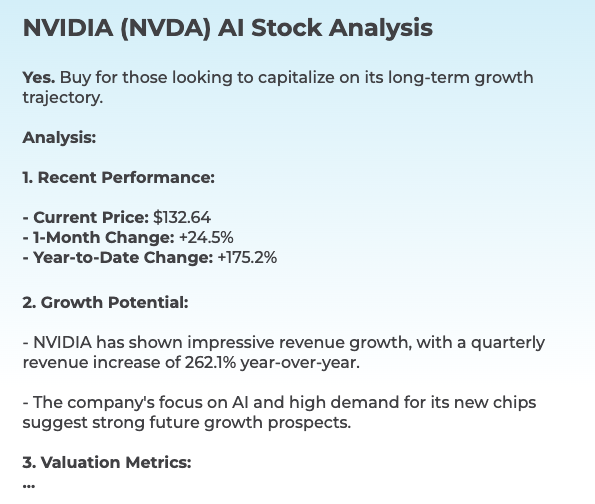20 Recommended Suggestions On Selecting AI Stock Predictions Platform Websites
20 Recommended Suggestions On Selecting AI Stock Predictions Platform Websites
Blog Article
Top 10 Tips On How To Assess The Accuracy And Performance Of Ai Stock Predicting And Analyzing Trading Platforms
You must verify the accuracy of AI trading platforms that predict and analyze the price of stock. This will ensure you are using an accurate tool. Here are ten top suggestions for evaluating these platforms.
1. Backtesting Results
What to Look For Find out if the platform offers backtesting capabilities that allow you to test how its predictions performed on historical data.
Why It Matters Backtesting can confirm the AI model's accuracy by comparing its predictions with actual historical results.
Tip: Look for platforms that allow you to modify the parameters of backtesting (e.g., time frames, asset classes).
2. Real-time tracking of performance
What to Watch Out For What the platform does during real-time conditions.
What's important: The platform's real-time performance provides a much better measure of its effectiveness than relying solely on historical backtesting.
Utilize a free trial or demo account to track and compare the accuracy of real-time forecasts to the actual market movements.
3. Prediction Error Metrics
What to Look for Utilize metrics like Mean Absolute Error and Root Mean Squared Error or R-squared, to determine the accuracy of your predictions.
What is the significance of these indicators are a method to gauge how closely predictions are in line with the actual results.
Tips: Platforms that openly share their metrics tend to be more transparent and trustworthy.
4. Ratio of Success and Win Rate
What to look for The platform's success ratio and win rate (percentage correct prediction).
Why is it Important: High win rates and success ratios suggest greater predictive accuracy and potential profits.
It is essential to be cautious about platforms that make unrealistic claims (e.g. 90%, for instance %+),) in the sense that the system cannot guarantee its success.
5. Benchmarking Market Indices against Benchmarks
What to Look For What to Look For: Compare the platform's forecasts and performance to the major market indexes (e.g., S&P 500, NASDAQ).
What is crucial because it allows you to determine whether this platform outperforms (or is underperforming) the wider market.
TIP: Look for an outperformance that is consistent over a variety of time periods, not just short-term gains.
6. Consistency in Market Conditions
What to Look For: Assess how the platform performs in different markets (bull markets or bear markets, high volatility).
Why It Matters A solid platform must be able to perform in a variety of market environments, not just during favorable conditions.
Test the platform's predictions in volatile markets or during markets that are down.
7. Transparency in Methodology
What to Look For How to recognize AI algorithms and models (e.g. neural nets, reinforcement learning).
Transparency of methodology lets you evaluate the scientific credibility and reliability of the system.
Tip: Avoid platforms that employ "black box" models without describing how predictions are generated.
8. User Reviews and Independent Testing
What to look for Review reviews from other users and look for independent tests.
Why it is important: Independent reviews and tests provide unbiased information about the platform's accuracy and performance.
Read user reviews on forums such as Reddit copyright and financial blogs.
9. Risk-Adjusted Returns
What to Look Out For: Evaluate the platform's performances by using risk-adjusted metrics like Sharpe Ratios or Sortino Ratios.
What is important: These metrics account for the risk level taken to achieve returns, providing an overall picture of performance.
Tips: A high Sharpe Ratio (e.g. over 1) suggests higher risk-adjusted return.
10. Long-term record-breaking records
What to look out for Check the performance of the platform over a longer period (e.g. for 3-5 year).
What is important Why it matters: Long-term performance is a more reliable indicator than shorter-term outcomes.
Do not use platforms that only showcase results that are short-term or cherry-picked.
Bonus Tip: Use Demo Accounts to test.
Try out the platform's real-time predictions with a trial or demo account, without having to risk your real money. This allows you to assess the accuracy and efficiency.
By following these tips you can assess the accuracy as well as efficiency of AI platforms for stock analysis and forecasting. Choose one that's compatible with your needs for trading and your risk tolerance. Remember that no system can be trusted, and mixing AI insights with the results of your own research is often the best option. Take a look at the most popular stock ai for website recommendations including best ai trading app, trading with ai, ai for stock predictions, ai stock trading app, ai trading tools, ai for stock predictions, ai stock trading, chart ai trading assistant, stock ai, ai for investment and more.
Top 10 Tips For Evaluating The Regulatory Compliance Of Ai Stock Predicting/Analyzing Trading Platforms
Regulatory compliance is a critical factor when looking at AI trading platforms for stock prediction or analysis. Compliance ensures that a platform complies to financial regulations, and adheres to legal frameworks and protecting user data. This minimizes the chance of legal or financial concerns. Here are top 10 tips on how to evaluate the conformity of these platforms.
1. Verify the Licensing & Registration
Regulators: Check that the platform is certified and registered with relevant financial regulatory agencies (e.g. SEC in U.S.A., FCA UK, ASIC Australia).
Verify the broker partnership If your platform has a partnership with brokers and brokers, be sure that these brokers are also licensed and regulated.
Public records: Go to the website of the regulator to determine whether the platform is registered or has been in violation of the law.
2. Verify Data Privacy Compliance
GDPR In the event that you are operating or providing services to users in the EU Make sure the platform is compliant with the General Data Protection Regulation.
CCPA : California Consumer Privacy Act (CCPA) compliance should be checked by users.
Data handling policies: Read the policy of the platform on privacy of data to ensure that it clearly outlines how data from users are stored, used and shared.
3. Evaluation of Anti-Money Laundering Measures
AML Policies: Make sure the platform has AML policies that are strong to detect and stop money laundering.
KYC procedures Check to see whether your platform is following Know Your Customer processes for confirming user identity.
Monitoring transactions: Find out whether the platform can monitor transactions and reporting suspicious transactions to relevant authorities.
4. Make sure that you are in conformity of your business with Trading Regulations
Market manipulation: Make sure that the platform has measures to prevent market manipulation, such as fake trading, wash trading.
Types of orders: Check if the platform complies with rules regarding types of orders (e.g. there is no unlawful stop-loss hunting).
Best execution : Make sure that the platform employs top execution techniques to complete trades at the most competitive cost.
5. Cybersecurity Assessment
Data encryption - Ensure that the platform is using encryption to secure data either in transit or when it is at the rest.
Incident response - Verify the plan of the platform to respond in case of cyberattacks or data breaches.
Verify any certifications.
6. Transparency and Disclosure
Disclosure of fees. Be sure that all charges and fees are disclosed clearly, including any hidden or additional costs.
Risk disclosure: Check if the platform has clear risk disclosures, especially for high-risk or leveraged trading strategies.
Performance reporting - Check to see if there are accurate and transparent performance reports made available by the platform to its AI models.
7. Make sure you're in the compliance of international regulations
Transborder trade If you are planning to conduct international trade, ensure that the platform is compliant in all jurisdictions.
Tax reporting: Check if there are reports or tools to assist you in complying with the tax regulations.
Sanctions compliance - Make sure that the platform is compliant with international sanctions and does permit trading only with countries or entities prohibited.
8. Reviewing Audit trail trails and Record-Keeping
Transaction records: Ensure the platform maintains accurate records of all transactions for regulatory and audit purposes.
Recordings of user activity: Check whether the platform records user activity including logins or trades, as well as any modifications to account settings.
Audit readiness: Find out if your platform can provide the necessary logs and documentation in the case of an inspection from a regulatory authority.
9. Examine whether you are in compliance with AI Specific Regulations
Algorithmic trading regulations: If a platform allows algorithmic trading, ensure it complies with regulations like MiFID II in Europe or Reg SCI in the U.S.
Bias & Fairness: Check to determine if there are any biases that the platform is able to monitor and mitigate within the AI model. This will ensure fair and ethical trade.
Explainability: Make sure the platform has clear explanations of AI-driven predictions and decision making, as required by some regulations.
10. Review user feedback and the history of regulatory compliance
User reviews: Read user feedback and then compare it with the platform's conformance to norms of the industry.
The history of regulatory compliance - determine if the website has been convicted of any previous penalties or violations of regulations.
Third-party Audits: Verify that the platform has been subjected to third-party reviews to ensure it is conforming to all laws and regulations.
Bonus Tips
Legal consultations: You may need to speak with a lawyer in order to determine if the platform is compliant with relevant regulations.
Trial period: Try the platform for free, or utilize the demo feature to test the compliance features as well as the documentation.
Support for customers - Ensure that the platform is able to provide assistance for any compliance-related concerns or questions.
These tips will help you assess the compliance with regulations for an AI stock-predicting/analyzing trading platform. You can choose a system that complies with the legal frameworks and safeguards your interests. Compliance not just reduces the legal risk but also increases trust in a platform's service. See the best chart ai trading tips for site advice including how to use ai for stock trading, free ai stock picker, ai tools for trading, best ai for stock trading, best ai trading platform, how to use ai for copyright trading, ai stock investing, ai stock predictions, best ai penny stocks, ai in stock market and more.